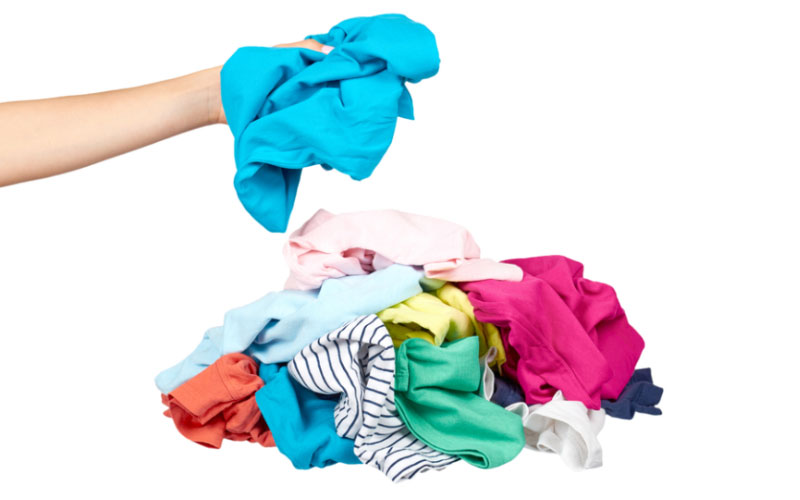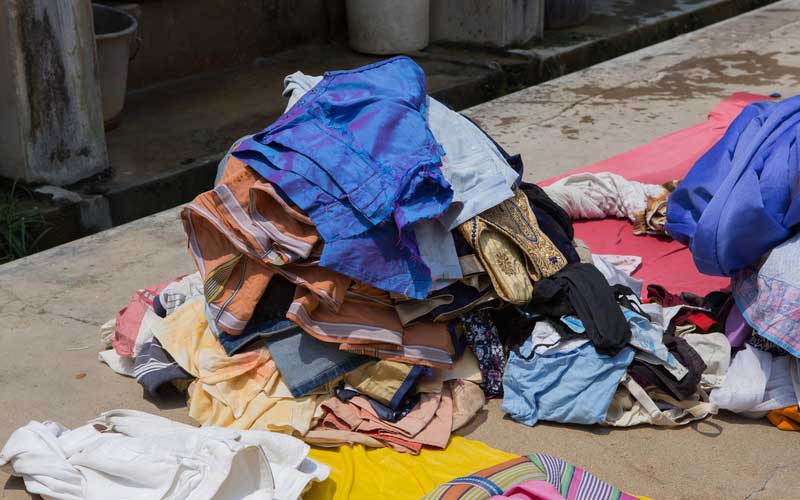Sometimes, a faulty part of the washing machine halts the laundry, which results in a laundry hamper being piled up with clothes. If this is the case with you, you can try washing clothes with your hands with similar results.
Some other clothing items like silk, wool, and delicate fabrics come with a label that says they must be hand-washed only. It would be best if you learned some techniques to avoid damaging and shrinking these clothing items in such a case.
Although washing clothes with hands requires more effort and a little extra work, the results are worth the effort. It also ensures the long life of your clothes without fading the color.
If you have not learned the process of hand washing clothes yet, learn it now. It will be beneficial while traveling and washing delicate items or when your washing machine suddenly stops. Follow the top tips to hand wash clothes with detergent to clean your laundry.
Do Hand Washing Clothes Work?
Long before the invention of washing machines, people used to wash clothes with their hands. You can wash clothes better with your hands, but it requires much more effort and energy.
When washing clothes with your hands, you have complete control over your actions. You can treat stains gently and would be better able to remove them.
In addition, most garments come with instructions that the clothes should be washed with hands. Spending your time and energy washing such garments in such a situation would be best.
Which Clothes Should I Hand Wash?
All the clothes in the washing machine can also be washed with hands. Although some clothing items are machine washable, they last longer when cleaned with hands.
Clothes labeled “dry clean only” should not be washed with hands. Such garments may not survive water and get ruined easily. It is better to take such clothing items to a professional. However, the clothes with a “dry clean” label can be washed by hand. This may include sweaters, blazers, scarves, etc., for such clothing items; washing these clothes in cold water is better than dealing with them gently.
What do I Need?
It would be best to have nothing special for hand washing clothes except for a few things. All the items used in doing laundry in the washing machine will be utilized here. For the sake of convenience, here are the things mentioned that you would need to wash clothes with your hands:
- two wide tubs
- detergent preferable in liquid form
- gloves
How to Handwash Clothes?

I will take you through the general method of handwashing clothes. This will be beneficial in washing lighter and darker clothes separately. However, you must follow different steps for delicate and other unique fabrics.
Step 1: Sort the Clothes
It is the most crucial step that should be followed whether you are washing clothes with your hands or in the washing machine. Always sort the clothes according to their color and weight. Keep all the whites aside and dark-colored garments separate from the lighter ones.
Similarly, separate heavy garments like coats and sweaters from your t-shirts and other lightweight clothes. Moreover, if you have new clothing with more potential to color bleed, you should wash it all alone.
Also, some clothes require exceptional temperatures or different detergents to be washed effectively. Do not forget to read the labels and combine the dresses with similar washing instructions.
Make sure to turn your dark-colored clothes inside out to prevent color fading.
By sorting the clothes, you can:
- Prevent color bleeding from one garment to another.
- Damage to lighter clothes due to the weight of heavier ones.
Once you are done sorting, check the zips and pockets of the clothes. Fasten the zips and buttons of all the garments and check the pockets for tissue papers and other small items.
Step 2: Pick the Right Products
It is good to go for a milder detergent as it is compatible with most fabrics. Such detergent will also be kinder on your skin as you must come directly in contact with the detergent. You can pick the regular detergent as well. Nevertheless, liquid soap also works great.
Go for detergents containing lanolin for woolen clothes. These detergents help keep the woolen clothes softer and prevent them from any damage during the wash.
However, you can pick a no-rinse detergent for delicate fabrics like silk. Once you soak your clothes into the detergent, these detergents do not require rinsing. Several high-quality no-rinse detergents are available in local markets and online stores. You can pick one according to your choice.
Read More: 10 Laundry Detergent Types You Must Know
Step 3: Wear Gloves
Do not forget to wear rubber gloves if you are sensitive to chemicals. Even if you are not allergic to chemicals like those present in detergent, you should still wear gloves as a precautionary measure to avoid any damage.
When you wash clothes with your hands, your hands come directly in contact with the detergent. Minor cuts are likely to appear in this case. Other than that, soaps and detergents dry our skin. The best solution to this problem is to wear rubber gloves.
Read More: 10 Best Laundry Soap Bars – In-Depth Review
Step 4: Fill the Tubs
Start by filling two deep and wide tubs with water. Ensure the tubs are deep enough to carry at least one piece of clothing. Fill the tub to its ¾, and ensure that the water temperature should not exceed 29 degrees Celsius. At this temperature, you should be able to touch the water quickly. Too hot water bleeds the clothes’ color, while cold water makes the detergent ineffective.
Step 5: Pour the Detergent
If you use liquid detergent, pour a tablespoon into one of those water-filled tubs. Let the detergent be fully dissolved in water. Mix it well to attain the best results.
Read More: Do You Pour Liquid Detergent on Clothes?
Step 6: Add the Clothes
Put the same colored clothes in the tub containing detergent and water. Let the clothes submerge entirely in water. If you have a tub large enough to soak all the clothes, you can do that in a single tub. But if the basin/tub is too small, you can put one cloth item at a time.
After that, move the clothes gently in the water in a circular motion to remove the dirt from the clothes. Beware only to move the clothes; do not attempt to rub or scrub them, as this can cause damage to your clothes.
Also, make sure that the clothes do not stay longer in the clothes. Let the clothes remain there long enough to remove the dirt and grease. Otherwise, the fabric will start shrinking.
Step 7: Rinse the Clothes
After washing the clothes in the detergent water, remove them from that tub and shift the dresses to the other tub containing clean water. It is time to rinse the clothes. Pull the clothes in and out of the water several times to get the detergent removed from them.
Keep pulling the clothes in and out until no detergent is left. You can entirely skip this step if you have used no-rinse detergent.
This step cleans the clothes thoroughly. Now you have to dry them.
Drying Hand Washed Clothes

A dryer can be wrong for the clothes that need hand washing. You can use the squeeze method to dry clothes. Without twisting or wringing the clothes, remove the water from the clothes gently by squeezing them. This way, try to remove as much water as you can. Then, hang the clothes in the open air to get them dried completely.
Tips to Hand Wash Clothes
Here are some tips that will be helpful to you in washing clothes with your hands.
Read the Label
Make it your habit to read the label before washing clothes. There are always some crucial instructions written on the brand that you might be unaware of. The label instructs whether the garment should be washed with hands or needs dry cleaning.
Check the Cloth for Color fasting.
Before washing the clothes with your hands, check a small hidden portion of the cloth for colorfast. If the dye does not fade or go away, you can easily continue washing it. However, you can change the detergent or washing method if the color bleeds.
Deal Unique Fabrics Carefully
Unique fabrics like lingerie, wool, silk, and baby clothes may change shape and color when washed in the washing machine. They retain their shape best when washed carefully with hands. However, silk garments with dark and bright colors should not be hand-washed.
Pretreat the Stains
If there are stubborn stains on your clothes, you should pretreat them before washing them. Apply stain remover or a small amount of liquid detergent directly on the color. Leave it for a while. Until then, you can prepare the water and detergent solution in the tub for washing clothes. Later, rub the stain with a brush and rinse it with water.
Read More: What Are These Blue Stains on My Washed Clothes?
Do Not Add Everything At Once in the Detergent/Tub
Always fill the tub/basin with water first. Do not stuff everything at once. This might seem more manageable, but it does not give the best results. Ensure the water is at its proper temperature before adding other stuff. Also, it is necessary to mix the detergent very well in the water. Otherwise, the detergent will leave residue on the clothes. The clothes should be added at the end when everything dissolves well.
Use Clean Tub/Basin
Make it your habit to clean the tub/basin before using it. Dirt residues are often stuck on the tub’s surface and stick to your clothes once you add them to the tub. This ruins your clothes thoroughly. This is why always using a clean tub/basin is a better practice. You can use a cup of white vinegar to clean the tub. It also does away with foul odor.
Always be Gentle to Your Clothes
Do not rub or twist the clothes. This will not only damage them but may also shrink the clothes. In addition, delicate fabrics cannot afford complex twisting and rubbing and thus get damaged. Just move the clothes gently in a circular motion in the tub. This will remove all the dirt easily from the clothes.
Wash Similar Clothes Together
Always try to wash clothes of the same fabric, color, and weight together. You can add lighter-colored clothes in one tub and darker ones in another. This will prevent color bleeding and save your expensive clothes.
Concentrate More on the Areas that are Prone to Bacteria
When washing clothing items like panties and trousers, wash the crotch and feet with more concentration. Since these areas are more prone to bacteria than other areas, you need to rub them with more strength to get the best cleaning results.
Read More: Can Bacteria Survive After a Clothes Wash?
Use White Vinegar for a Better Smell
If you use a light detergent with little to no odor, add white vinegar to the tub/basin containing clothes. After adding detergent, add ¾ cup of white vinegar to the water. This will kill all the bacteria and remove any foul smell from the clothes.
In Conclusion
Handwashing clothes will only seem daunting if you have never done it before. It may require more strength and time, but the outcome is always worth the effort.
A better choice of detergent, suitable transparent gloves, and two wide tubs will be enough to do the job. You can save your electricity bills by doing work with your hands. It is also safer for the environment. Other than that, delicate and other such fabrics will remain safe on washing with hands. You can also treat the stains well by rubbing them.
Ensure to use a light detergent and read the label of the clothes every time you wash them. This will save you from a lot of hassle.

